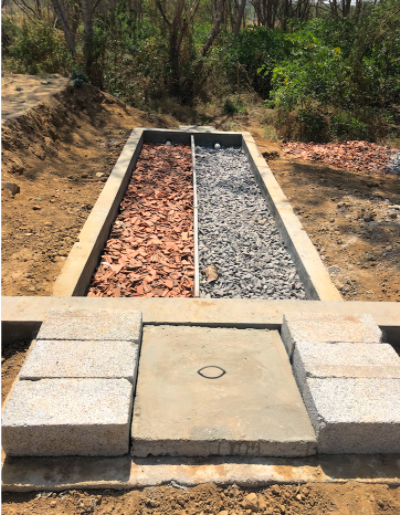In-Stream Decontamination system is a small-scale collaborative project constructed near the southern inlet of Soul Kere. This intervention is part of an ongoing collaboration which includes diverse partners spanning Design, Engineering, Civil Society, and Science perspectives. The six-fold partnership includes input from Biome Environmental Trust (project management, collaboration, coordination), MAPSAS (community engagement), Eco Paradigm (engineering and construction), Commonstudio (design), ATREE (monitoring), and Wipro (fiscal sponsorship).
This small scale intervention “model Nallah”, approximately 2M Wide and 8M long has been constructed next to the STP at Soul Kere.
Within this space, we will run a series of experiments with jelly stones and terracotta rubble materials. The first treatment will test the removal of organic contaminants by means of jelly and Terracotta rubble material. Terracotta has properties which makes it a viable biofilter media for urban wastewater. We plan to test the system for flows between 2.4 and 9.6 KLD.
The ultimate aim is to use the insights of the Sowl Kere studies to develop a series of larger interventions which can be placed directly within nallahs to prevent the contamination and eutrophication of urban lakes. We call this larger approach “Strategic In-stream Systems” or “STRAINS”— decentralized, frugal, flexible, and inclusive.
Progress Report
Objectives
Evaluate the performance of STRAIN system with respect to materials(Gravel and Terracotta)
in treating wastewater
Optimize the design of STRAINS for efficient removal of contaminants
- Develop an approach to enhance community participation and to hand over the maintenance of systems to the communities. This will help in promoting community engagement that will lead to a greater impact.
The project was implemented and monitored for a year. Please find detailed project report here
Conclusion
STRAINS showed good potential for dealing with highly variable influent quality. The removal efficiency was good for TSS and organic matter and satisfactory for nutrients in both setups. According to the results an average percentage removal of pollutants from the system was found as follows: TSS - 86% for gravel, 80% for terracotta; COD - 70% for gravel, 66% for terracotta; BOD - 80% for gravel, 79% for terracotta; TN – 13% for gravel,26% for terracotta; TP - 38% for gravel, 53% for terracotta
STRAINS showed similar performance for gravel and terracotta setup for total suspended solids and organic matter removal (p>0.05). According to the results terracotta showed better nutrient removal efficiency than gravel.
Higher organic loading rate of highly soluble effluent is decreasing the treatment performance of TSS, COD, BOD5, and nutrients. STRAINS achieved the better effluent quality when the system was loaded with COD ≤ 300g/m2/d. The corresponding removal efficiency observed in both gravel and terracotta setup was 69% and 50% respectively. Similarly, the optimum loading rate for BOD5 and TSS are found to be 44g/m2/d and 140g/m2/d respectively. At this optimum loading rate, the maximum removal efficiency of BOD5 recorded in gravel and terracotta setup was 80 and 83% respectively. Meanwhile, the TSS removal efficiency of gravel and terracotta setup was found to be 68 and 58% respectively.
The pollutants (TSS, organic matter, nutrients and coliforms) removal efficiency of pollutants in the lower half (4 -8 m) of the system was higher than overall efficiency (0-8m). Increase in contaminants levels were observed at the center of both the systems. This could be attributed to breaking down contaminants into simpler form as greywater moves towards the centre of the system.
STRAIN system is a pilot system which is deployed in the natural environment, with the construction activities going in the catchment, the quality of inflows to the system were highly variable which is interfering with the effluent quality.



No comments:
Post a Comment